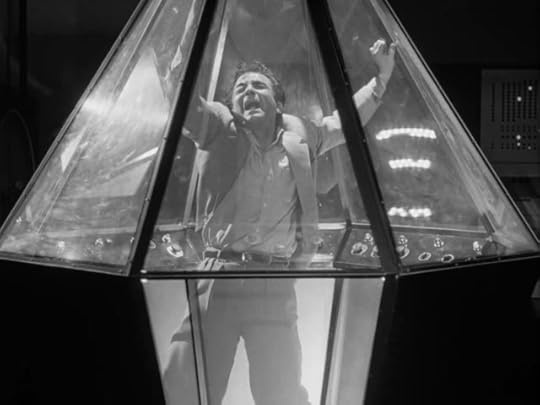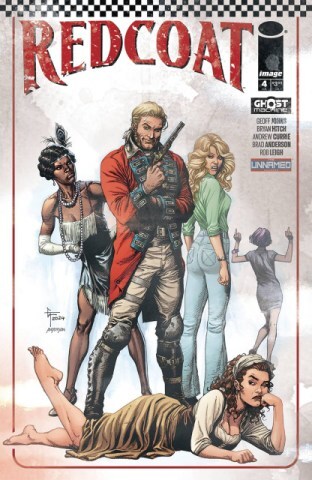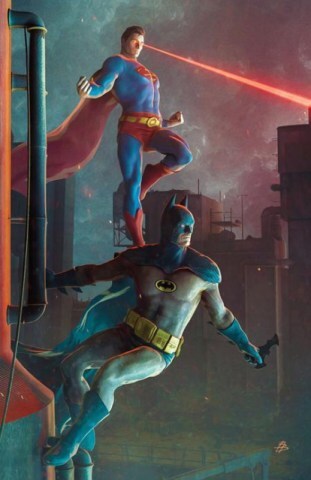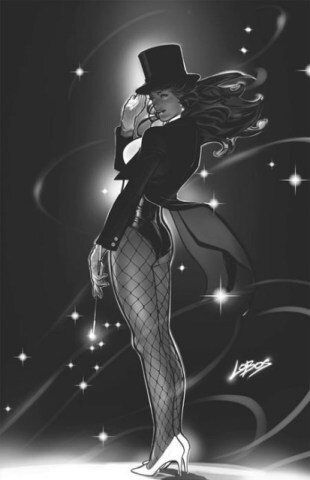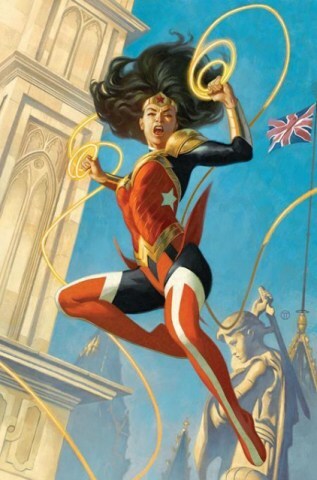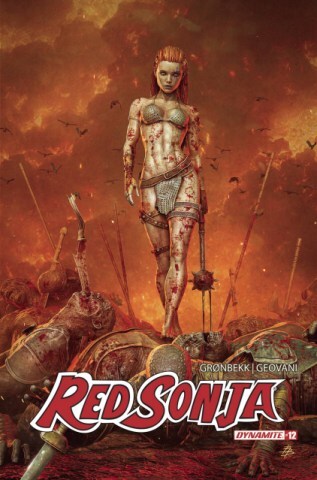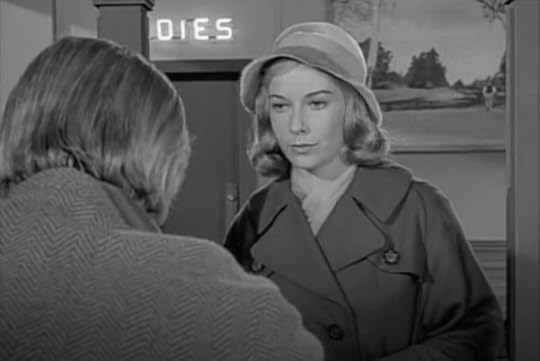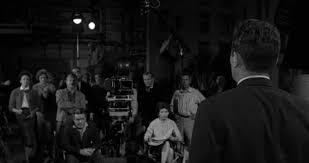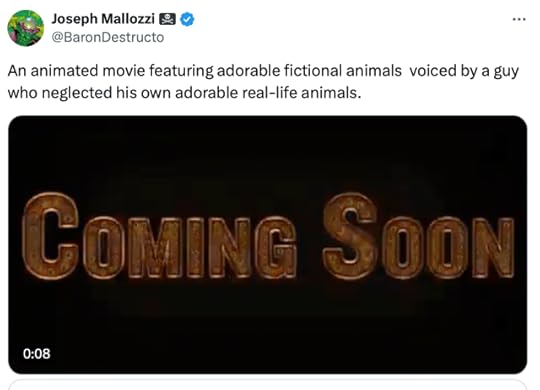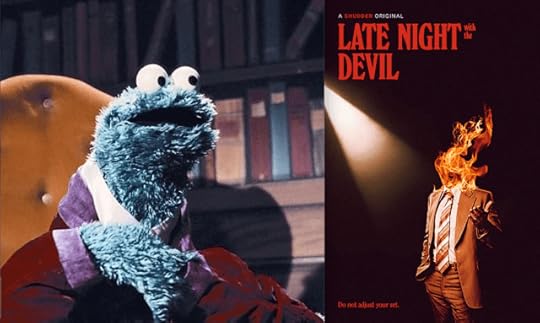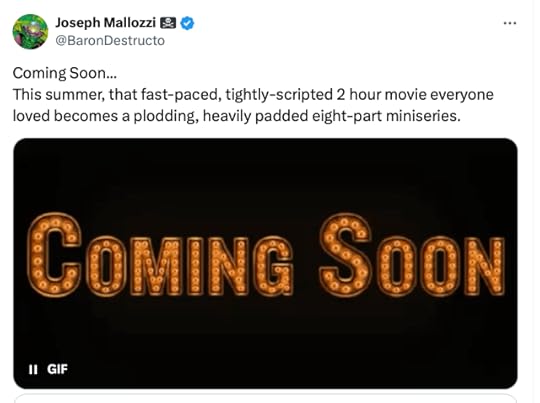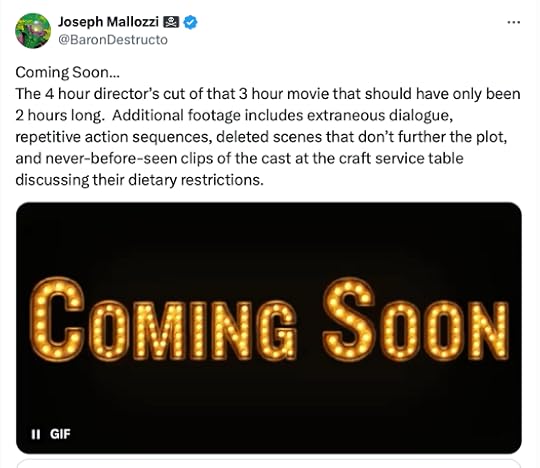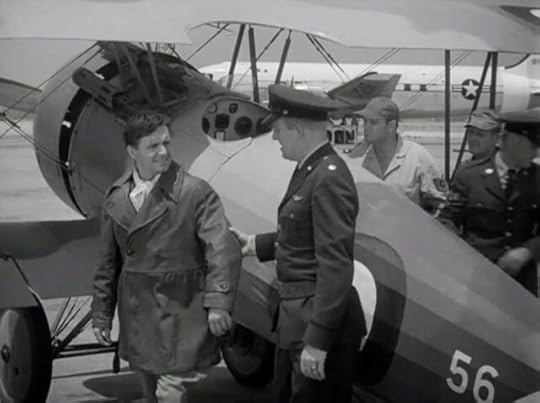Joseph Mallozzi's Blog, page 48
July 20, 2024
July 20, 2024: The Twilight Zone rewatch continues with Episodes 25-28!
Episode 25, “People Are Alike All Over”
This episode was first broadcast March 25, 1960.
The living room set is a redress of a set built for The Time Machine (1960) and was last glimpsed in “Third from the Sun”. The fence in the opening scene was also used in “Third from the Sun”. The ship’s interior is another re-use from Forbidden Planet (1956). The martian backdrop is also a re-use from the same movie.
This episode is based on the short story “Brothers Beyond the Void” by Paul W. Fairman. The television rights were acquired for a (at the time) lofty $2500. In the original story, the heroic Marcusson makes a solo trip to Mars while Conrad is only on hand to see him off. In adapting the story for television, Serling instead made the reluctant Conrad the protagonist – which, I think, was a wise choice.
When Serling first pitched this story to the network, the martians were described as shorter than humans and Conrad communicated with them via mathematics. In the end, it was decided that regular-sized individuals and mind-reading were more production-friendly.
The episode was named “Brothers Beyond the Void” up until the completion of production.
Actor Roddy McDowall, who plays Sam Conrad, started as a child actor and amassed over 150 films to his credit over the course of his illustrious career. A mistake by 20th Century Fox cost him a likely Emmy nomination for his performance in Cleopatra (1963) when he was listed as a lead rather than supporting role. He was lifelong friends with Elizabeth Taylor and built solid friendship with many of his former co-stars. Known for his portrayal of Cornelius in the Planet of the Ape movies, he also appeared in three different Batman series – Batman (1960) as the Bookworm, Batman: The Animated Series (1992) as the Mad Hatter, and the New Batman Adventures (1997) again as the Mad Hatter. Among the roles McDowall missed out on: the role of Nick in Who’s Afraid of Virginia Woolf, the role of Pennywise in the 1990 It miniseries, and the role of Arthur Carlson on WKRP in Cincinnati.
Susan Oliver who plays the regretful martian Teenya, was a licensed pilot, a Buddhist, and a baseball expert. Her attempt to become the first woman to fly a single engine plane solo from New York to Moscow was thwarted by Soviet officials who refused to let her enter their airspace. After surviving a commercial air crash, she sought hypnosis therapy to gain the courage to fly again. She is glimpsed in the end credits of the classic Star Trek (1966) series as the green-skinned Orion slave girl.
Vic Perrin who plays one of the duplicitous martians was the “control voice” on The Outer Limits (1963), a series he had, admittedly, never watched.
Oft imitated, never duplicated, “People Are Alike All Over” is another solid episode with a great twist that, while not unexpected given the martians’ unnerving benevolence, still lands after all these years. All the same, given the condition of their crashed ship and the unlikelihood that Earth was going to mount a rescue mission, I can’t help but feel it could have been a lot worse for Conrad. Hell, if the t.v. in his living room prison actually worked, he’d have even less to complain about.
Episode 26, “Execution“
This episode was first broadcast April 1, 1960.
Most of the equipment in Professor Manion’s lab was previously used in Forbidden Planet (1956), Satellite in the Sky (1956), and World Without End (1956). The noises of the time machine were used in previous episodes of the show and would later be used on Star Trek.
The part of Joe Caswell had originally gone to actor Neville Rand who actually went to the rehearsals for the episode but then fell sick on the first day of principal photography.
Author George Clayton Johnson on actor Albert Salmi who ended up stepping into the role of Joe Caswell: “He was very quiet, but I think that was because he was bottling up all his emotions for the role. He was a method actor. After seeing what he could do on the set when they filmed, I knew he was a wonderful actor.”
Albert Salmi’s first film role was in The Brothers Karamazov (1968) for which he turned down an Oscar nomination. On the other hand, he did accept the Western Heritage (Wrangler) Award from the National Cowboy Hall of Fame for his role in an episode of Gunsmoke, an award he purportedly cherished. Salmi and his wife died as a result of what police suspect was a murder-suicide in 1990.
Actor Russel Johnson who plays the part of Professor Marion is no doubt best known as the Professor on Gilligan’s Island. Prior to that casting, he was known for playing onscreen villains. Johnson was a decorated WWII bomber pilot and recipient of the Bronze Star, Air Medal with Oak Leaf Cluster, and the Purple Heart. He auditioned for, and missed out on the role of Ben Casey in the beloved series of the same name. In addition to narrating Robotech (1985), he appeared in two time travel-themed episodes of The Twilight Zone.
This is an episode where I thought the idea was far better than the execution. It had its moments however. Robert Salmi delivers and outstanding performance as the way-in-over-his-head Caswell and his speech to Professor Marion baring his soul is Emmy-worthy. And I did love the moment when Caswell ends up trapped in the phone booth, like Mike Ferris in “Where Is Everybody?” and Rod Serling before him. I did find the conveniently late arrival of the crook who, ironically, strangles Caswell and then ends up sharing his fate via the hangman’s noose a little contrived, even by early 1960’s Twilight Zone standards. Still, Salmi’s performance saved the episode for me.
Episode 27, “The Big, Tall Wish”
This episode was first broadcast April 8, 1960.
“The Big, Tall Wish”, with its almost all-black cast, was groundbreaking television at the time and ended up earning the show a 1961 Unity Award for Outstanding Contributions to Better Race Relations.
Boxer Archie Moore was originally cast as Bolie Jackson, but the demands of production proved too great for him and he was replaced with actor Ivan Dixon.
Ivan Dixon starred as P.O.W. radio tech Kinchloe in four seasons of Hogan’s Heroes, ultimately leaving the show after feeling dissatisfied with the role. Prior to that, Dixon had earned critical acclaim playing Joseph Asagai in “Raisin in the Sun”, the first play written by a black woman produced on broadway. Sidney Poitier was the star and he and Dixon became life-long friends, working together on such productions as Something of Value (1957), Porgy and Bess (1959), and A Touch of Blue (1965). While working on Hogan’s Heroes, Dixon found time to star in “The Final War of Olly Winter”, a drama special for which he earned an Emmy nomination in 1967. In 1970, Ivan Dixon shifted focus to directing, helming a handful of films and countless television shows. He worked tirelessly to promote black actors and his efforts were recognized with four NAACP Image Awards, the National Black Theatre Award, and the Paul Robeson Pioneer Award from the Black American Cinema Society.
Kim Hamilton who plays Frances Temple in this episode was the only African-American actor to appear in Leave it to Beaver (1957). She was also the original Mrs. Willis on All in the Family, a role Roxie Roker would make famous on The Jeffersons. In 1997, Hamilton married Werner Kemplerer who played Colonel Klink alongside Ivan Dixon on Hogan’s Heroes.
Steven Perry who plays the young Henry Temple in this episode owns Stevie’s Creole Cafe in Los Angeles.
Very strong performances across the board buoy an episode weighed down by maudlin sentimentality and an all too slow-moving story. The boxing action also could have been better staged. Whereas past episodes have been pretty clear in their messaging, this one feels muddled. Bolie is, ultimately, denied his happy ending because of his refusal to believe in what is essentially fantasy, the imaginings of a young boy that surely can’t be a plausible option no matter how dire his reality. It feels like Bolie is punished for what amounts to not choosing to live in the Matrix.
Episode 28, “A Nice Place to Visit”
This episode was first broadcast April 15, 1960.
This episode, written by Charles Beaumont, was originally titled “The Other Place”.
CBS Standards and Practices was all over this episode, requesting several script changes. Among them, changing “broad” to “doll” or “chick”, replacing “stacked” with “built like…”, switching “You wanna come up and ball it up a little?” to “You wanna come up and party a little?”, and changing “scoring with a chick” to “being a big guy with a chick”. When the woman in Rocky’s bedroom asks “Anything else I can do for you?”, they noted: ““Please he certain that the girl’s third speech be delivered in a sweet manner, as described.”
Rod Serling was disappointed with the name of the casino being “The Casino”. He had reached out to several Vegas casinos in the hopes that one of them would lend their name to the production, but there were no takers.
The slot machine features in this episode was also used in an earlier episode, “The Fever”. The set used for the Hall of Records looks very similar to the post-apocalyptic library in “Time Enough At Last”.
At one point, Rocky requests a million bucks in “5G notes”. These $50000 bills were still in circulation at the time this episode was produced.
The role of Rocky Valentine was initially intended for Mickey Rooney. But when Rooney was unable to accept, Charles Beaumont suggested Serling take the role. For some reason, Serling passed.
Larry Blyden, who would play two-bit criminal Rocky Valentine in this episode broke out on Broadway, earning a Tony Award in 1972. During the 50’s and 60’s, he guested on numerous t.v. anthologies. A big fan of game shows, he served as a semi-regular panelist on Password (1961) and To Tell the Truth (1969), eventually assuming hosting duties on What’s My Line ? (1968). A collector of antiques, Blyden would travel around the world in search of new pieces for his collection. On one such trip to Morocco in 1975, he was carjacked and murdered.
Sebastian Cabot who plays the role of the affable Pip is perhaps best known for his portrayal of Mr. French in the television series Family Affair. Although he earned a living playing posh, upper-crust characters, Cabot had a very tough, working-class upbringing. Cabot left school at an early age (14) and worked odd jobs before discovering a passion for acting, eventually moving to the U.S. and playing Dr. Cary Hyatt in the detective series Checkmate. He was a voice actor who did a lot of work for Disney and was the original narrator of the Winnie the Pooh series. A year after playing Santa on Miracle on 34th Street (1973), Cabot suffered a stroke. He retired to Deep Cove, British Columbia where he passed away after suffering a second stroke three years later.
This was an enjoyable episode that, while possessed of a memorable twist, doesn’t quite reach the lofty heights of some of Twilight Zone’s best. While I thought Sebastian Cabot was fantastic as Pip, I found Larry Blyden’s almost lunatic turn as Rocky Valentine silly, at times annoyingly so. That dance sequence! Oof. While I get the idea of the Living Hell of having everything you could ever want, I honestly think I could used to it after a while. I don’t know.
So, what did you all think?
The post July 20, 2024: The Twilight Zone rewatch continues with Episodes 25-28! appeared first on Joseph Mallozzi's Weblog.
July 19, 2024
July 19, 2024: Recent Yes/No’s – Best and Worst!
7-Eleven Slurpee Twinkies and Drumsticks?
Brie Butter?

Pickleback Cupcakes?
Big Mac Taco?

Elden Ring’s Neutralizing Boluses?

S’mores Ramen?
Deviled Egg Sushi?

See-Through Pudding?
Love and Peach Frappuccino?
KFC-flavor Potato Chips?
BEST: Big Mac Taco
WORST: S’mores Ramen
The post July 19, 2024: Recent Yes/No’s – Best and Worst! appeared first on Joseph Mallozzi's Weblog.
July 18, 2024
Script notes!
Thanks for the script. Overall, the plotting feels contrived and, at times, defies logic, so we’re going to require a fairly extensive rewrite for the second draft.
Our biggest issue with the script is the characterization of the Secret Service who come across as so inept that it defies credulity. Specifics to follow.
Could we put the building that the shooter climbs onto OUTSIDE a proper security zone instead of the current Pac Man configuration that only excludes his position?
The Secret Service Director character seems to lack the intelligence one would expect from someone in their position. Please have her come up with something more plausible than the “too slopey!” excuse for why no armed agents were stationed on the rooftop. Let’s work a little harder to create a more clever explanation for the egregious lapse in professional conduct, one that our audience could buy into. Maybe the shooter incapacitated the agents inside the building through non-lethal means, say a knock-out gas or drugs in their water supply. This could also explain how the shooter could have carried the ladder over, propped it up to the building, and climbed up without being noticed by law enforcement.
Speaking of the ladder, can we make it a lightweight retractable model instead of the 20 foot heavy version he is currently lugging around in the script? Or, better yet, could it already be there? Maybe the security personnel were planning to use it to climb onto the roof later or repairs were being effected to the roof earlier that morning.
Could we come up with an alternative explanation for why the Secret Service is curtailed rather than the current “He had to share with the President’s wife”?
I’m bumping on the idea of the Secret Servie outsourcing the protection of a Presidential candidate to a local police detachment of 12 officers. Can we double that number?
Can we lose the scene where the shooter passes through the security screening hours before the shooting with a rangefinder and is clocked by the Secret Service but nobody does anything about it? It makes them look incompetent.
Also lose the beat where the shooter’s family contacts law enforcement to warn them that their son has gone missing with an AR-15 three hours before the assassination attempt.
Can we not have the shooter spotted on the rooftop by the attendees? While I appreciate your attempt to ramp up the tension, having 30 minutes pass between the moment people point him out to when he finally takes the shot really feels like a stretch. Instead of all these people spotting him and shouting at authorities to no avail, how about making it a lone child instead? Say a three year old loses their balloon and watches it drift skywards, past the rooftop, where he sees the man on the roof. He turns to his mother and says: “Mommy, there’s a man on the roof!” But when his mother looks, there is no one there as the shooter has ducked down and the roof fully obscures him. His mother, of course, dismisses her son’s comment as the product of a child’s imagination.
Still bumping on why the sniper takes so long to shoot if he has spotted the threat (20 minutes earlier! Come on.). As a trained professional, he would have never allowed the shooter to get those shots off. The explanation that he was awaiting the green light from his superiors is a huge buy. I’d suggest some sort of communication breakdown but even that doesn’t really feel right. Let’s think on it.
The fact that the Secret Service allows the Presidential candidate onto the stage after an alert about the shooter goes out on an “all tactical channel” is a huge plot hole.
The shooter character feels cliche. Single young white male, bullied through high school, elects to act out by…trying to assassinate the Presidential frontrunner? Why? Let’s dig into his motivation a little more, come up with something that doesn’t rely on the tired “crazy loner” trope. Also, I have to admit to laughing out loud with the reveal that he is a registered Republican, an unintentionally hilarious twist that, I’m afraid, feels a little perfunctory and is not going to fool the audience. Having a record of him donating to a progressive committe just muddles the backstory here. The explosives in the car and bomb-making materials at his home also feel a little on the nose. Finally, could we get this guy SOME sort of internet presence? After all, he’s 20-years-old, not some octagenerian Luddite. Maybe an unremarkable instagram account or occasional post on reddit. If you want to lean into the “crazed conservative” angle, maybe give him an account on the X platform and have him retweet Mitt Romney or Adam Kinzinger.
Having the media break a story, days later, of a plot by Iran to kill the Presidential frontrunner is confusing, unncessary, and, when you think about it, actually makes the Secret Service look even worse because you’re effectively saying they were expecting an attack, heightened the security detail, and were STILL caught with their pants down. Suggest swapping out Iran for Russia in keeping with the current trend.
The DHS Secretary feels like your typical cartoon villain. Is there a way to humanize him a little? Maybe give him a funny dog? One of those Chinese Cresteds would be great!
The t.v. host that hints at the possibility the assassination was staged is great goofy comic relief! Just be careful not to make her too over-the-top delusional/loopy. A little goes a long way here.
I do have to admit that the revelation shadowy individuals shorted millions of shares of the Presidential frontrunner’s company to, presumably, cash in on his expected demise was very interesting as it adds another layer of intrigue, hinting at that broader, more insidious conspiracy you’ve already layered in. Would be great to hint at their comeuppance, the significant financial loss they incurred when their plans fells through.
That’s it for now. Looking forward to seeing how you address these notes in the rewrite!
The post Script notes! appeared first on Joseph Mallozzi's Weblog.
July 17, 2024
July 17, 2024: Amazing Covers!
A few that caught my eye this week…
Namor #1 – cover art by Alex Maleev
The Incredible Hulk #14 – cover art by Gabriele Dell’otto
Redcoat #4 – cover art by Gary Frank, Brad Anderson
Batman/Superman: World’s Finest #29 – covert art by Bjorn Barends
Superman #16 – cover art by Pablo Villalobos
Wonder Woman #11 – cover art by Julian Totino Tedesco
Red Sonja #12 – cover art by Lucio Parrillo
Red Sonja #12 – cover art by Bjorn Barends
Somna – cover art by Tula Lotay
So which were YOUR favorites?
The post July 17, 2024: Amazing Covers! appeared first on Joseph Mallozzi's Weblog.
July 16, 2024
July 16, 2024: Our Twilight Zone rewatch continues with episdoes 21-24!
Episode 21, “Mirror Image”
This episode was first telecast February 26, 1960.
Rod Serling got the idea for this episode from an incident where he spotted someone at an airport with the exact same height and build as him, wearing the exact same clothes, carrying the exact same briefcase. He imagined how creepy it would be if the guy turned around and – it was him! In the end, it turned out not to be him but, according to Serling, a younger handsomer version of himself. Still, a story idea was born.
The story resembles Anthony Armstrong’s short story/novel “The Strange Case of Mr. Phelam”, about a man who survives a car crash only to find himself stalked by his own doppelgänger. Alfred Hitchcock ended up purchasing the television rights for his Alfred Hitchcock Presents.
Jordan Peele, a life-long fan of the show, cites this episode as an influence on his movie, Us. The entirety of the episode was shot on Stage 25 on the MGM lot.
The chase sequence at episode’s end was achieved through the use of rear projection, having actor Martin Milner run in front of a screen projecting a shot of Milner running down the street in pursuit.
Vera Miles plays the part of the overwhelmed Millicent Barnes. Born Vera Ralston, the former Miss Kansas changed her name to Vera Miles because there was already a working actress named Vera Ralston working in Hollywood at the time she moved to L.A. Hitchcock cast her in an episode of his show and, impressed by her performance, dubbed her “the new Grace Kelly” and cast her opposite Henry Fonda in The Wrong Man, ultimately signing her to a 5-year deal. This was the same year John Ford cast her in “The Searchers.” Hitchcock cast her as Judy Barton in Vertigo but she had to bow out of the part due to pregnancy. She was originally cast as Mario Crane in Psycho while Janet Leigh was slated to play Lila Crane, but Hitchcock ended up reversing the roles. Vera Miles retired from acting in 1995 and remains, today, the longest surviving cast member of Psycho.
Actor Martin Milner who plays the helpful Paul Grinstead in this episode got his start in the business through a happy connection. Jack Webb, the creator of Dragnet, owed him money from a card game and when Milner swung by the studio to collect, Webb cast him in the Dragnet radio show. They formed a fast friendship and, soon after, Webb cast him in the role that would mark the high-point of Milner’s career: Pete Malloy on Adam-12. Before Adam-12, however, came Route 66, a ground-breaking road series that shot coast-to-coast and made Martin Milner a household name. Milners was apparently the visual inspiration for DC Comics’ Green Lantern Guy Gardner.
This one was a delightfully unnerving episode from the get-go. I’m sure you didn’t miss the framing of the “LADIES” room sign in an early shot that obscured the first two letters to read “DIES” behind Millicent as she inquires at the ticket booth. The episode does a beautiful job on exploring what would become a recurring theme on the show, the uncertainty of identity and its tenuous mooring to reality. As much as I loved the single setting, I thought the bus station was too small and underpopulated to believe neither Millicent nor the other occupants would have noticed the two Millicents crossing paths at some point. That medium-sized quibble aside, I really enjoyed “Mirror Image” and especially the ending. The sequence of Paul’s desperate attempt to keep up with his double is all the more unsettling for the fact his doppelgänger is actually smiling, suggesting malevolence at play. Creepy.
Episode 22, “The Monsters Are Due on Maple Street”
This episode was originally broadcast March 4, 1960.
“The Monsters Are Due on Maple Street” shares similarities with Raymond F. Jones’ “The Year When Stardust Fell”, a 1958 novel in which a comet’s passing precedes a worldwide cessation of machine function which eventually leads to mob rule.
The aliens at the end of this episode are wearing uniforms from Forbidden Planet. The Maple Street location of this episode would later be used in season 5’s “Stopover in a Quiet Town”.
Actor Claude Akins, who plays Steve Brand in this episode, enjoyed a busy 40 year career that included 100 films and over 180 t.v. episodes. He was General Aldo in Battle for the Planet of the Apes (1973) but is probably best known as the titular hero in television series The Misadventures of Sheriff Lobo. He was, by all fan accounts, incredibly gracious and friendly, always happy to honor autograph requests.
Actor Burt Metcalfe, who has a small role as Don Martin, was a casting director for Universal when he landed a producer credit on MASH. He worked his way up to Executive Producer, staying on for the show’s entire run, the only producer to do so.
Actress Anne Barton, who plays Myra Brand, was Eddie Haskell’s mom in Leave it to Beaver.
Actor Robert McCord, who plays the ice cream man in the opening scene, appeared in over 60 episodes of The Twilight Zone, mostly as an uncredited extra.
I think I’m experiencing my own Mandela Effect as I was sure I’d read this story in high school as part of a Ray Bradbury collection but, to my surprise upon researching the episode for this rewatch, I discovered this was an original story by Rod Serling. Anyway, this episode is clearly influenced by the Cold War mentality at the time and the paranoia-fueled McCarthy trials that sought to root out communists in everyone’s backyard. The episode does a nice job of ramping up the paranoia despite the occasional leaps in logic necessary for the story to work (ie – No one can walk down a couple of blocks to find out what’s going on. Well, no one can do so without getting shot and killed evidently.). The aliens at the end had a nice Kang and Kodos vibe, predating The Simpsons’ would-be-conquerors who would premiere 30 years later. This episode gets a lot of well-deserved love but I just found some of the mob assumptions just a tiny bit convenient at times. Overall though, great episode.
Episode 23, “A World of Difference”
This original broadcast date for this episode was March 11, 1960.
This episode would prove the inspiration (in some cases subconscious?) for an episode of Eerie, India, Mad About You’s “Up in Smoke”, Stephen King’s short story “Umney’s Last Case”, and the movie The Truman Show – among many others.
This episode was shot throughout the MGM Studios backlot including the famous Philadelphia Story house, built for the 1940 movie, that played as the exterior to Arthur Curtis’s suburban home.
Arthur’s decision to book a trip to San Francisco was a tip of that to actor Howard Duff who gained fame as Sam Spade in the The Adventures of Sam Spade, set in San Francisco. Duff was married to actress Ida Lupino who played the role of faded screen star Barbara Jean Trenton in Episode 4, “The Sixteen-Millimeter Shrine”. They were THE Hollywood IT couple at the time and co-starred in their own series, Mr. Adam and Eve, eventually divorcing after 15 years of marriage. One of Howard Duff’s last roles was as Paul Galveston on the series Knots Landing.
David White, who plays Arthur’s level-headed agent, Brinkley, is perhaps better known as Darrin Stephens’ boss, Larry Tate, on the television series Bewitched. He would appear in 191 episodes of the show, second only to series lead Elizabeth Montgomery.
Eileen Ryan, who plays the part of the nagging Nora Raigan, was the mother of actors Sean and Chris Penn, and musician Michael Penn.
Gail Kobe, who plays Arthur’s helpful secretary, Sally, became a producer for daytime soaps, eventually earning a position as an Executive Producer on The Guiding Light.
Susan Dorn, who plays Curtis’s wife, Marion, would, decades later, have her therapy license revoked after admitting that Nicole Brown Simpson had confided in her about the domestic abuse she had suffered.
Another interesting episode exploring the uncertain nature of identity. To be honest, I have very mixed feelings about this one. On the one hand, if you interpret it as a more traditional Twilight Zone episode, then poor family man Arthur Curtis was thrown a scare but managed to effect an 11th hour escape back to his reality. BUT, if your interpretation is the opposite, that the character we are following is, in fact, actor Gerald Raigan, then we are watching a man’s mental collapse and subsequent retreat from reality, a result of stress, excessive drinking, and the pressures of an overbearing wife. It’s really quite depressing. There are arguments to be made for both interpretations but what cinches is it for me is the final scene that takes place on the set, this time free of our protagonist’s POV, strongly suggesting that this is, indeed, reality. Like I said, depressing. While Arthur Curtis makes good his escape, Gerald Raigan’s breakdown is complete. Apparently, after the episode aired, more than a few people wrote in asking for an explanation of the ending. I’m interested to hear your interpretations.
Episode 24, “Long Live Walter Jameson”
This episode originally aired March 18, 1960.
The original title of this episode was “Forever and a Day”, but it was changed after production.
“Long Live Walter Jameson” was originally scheduled for a 3-day shoot, but the complexity of the aging sequence required an extra day of filming. Walter’s onscreen aging was achieved through the use of red color age make-up and red key lights. According to actor Kevin McCarthy: ““The ten or fifteen seconds on the screen when I age was done with red and green lines on my face. We shot the film in black and white with red and green filters. When we switched the color filters, the lines that were obscured appeared on the screen and it looks like I age without any special effects. The man who did the makeup on me that day told me when he did the same trick for Dr. Jekyll and Mr. Hydge, it cost the studio $5,000. Now he was doing it for The Twilight Zone and it was costing them $25,000!”
This episode was written by Charles Beaumont who would, ironically, pass away at the very young age of 39 due to early-onset-Alzheimers. In contrast, the cast of this episode lived exceptionally long lives.
The exterior of Jameson’s house is the same suburban home exterior glimpsed last episode, originally constructed for the 1940 film The Philadelphia Story. The living room interior and front door entrance were built for The Time Machine (1960) and repurposed throughout the show’s first season.
Actor Kevin McCarty who plays the titular character in this episode appeared in over 100 films, among them a starring role in the 1956 Invasion of the Body Snatchers. He was a distant cousin of reviled US Senator Eugene McCarthy.
Actress Estelle Windwood who plays the elderly, spurned former wife Laurette Bowen, made her final onscreen appearance as a guest star on a 1979 episode Quincy at age 96, making her the oldest working actor in the U.S. At age 95, she admitted to being a 3-pack-a-day smoker. She lived to 101.
I’m admittedly not as big a fan of the supernatural stories and even though this episode was more talky than most, I did enjoy the set-up, especially Walter’s admission that his is an actual living hell, watching those he loves grow old and die. Well, the ones he doesn’t abandon anyway. Again, you knew where this one was headed right down to the last dusty shot, but it delivered well nevertheless. I did find the “young” Susanna character…weird. Given her almost infantile behavior and deference to her father, I figured she was supposed to be 16 only she turned out to be 30 (!) which made her pending marriage much easier to swallow but still equally bizarre as Walter treated her like a daughter as well. I wasn’t married in the late 50’s/early 60’s, so I can’t say the relationship dynamics depicted in this episode are atypical, but boy did they leave me uneasy. What did you all think?
The post July 16, 2024: Our Twilight Zone rewatch continues with episdoes 21-24! appeared first on Joseph Mallozzi's Weblog.
July 15, 2024
July 15, 2024: Coming Soon!
July 14, 2024
July 14, 2024: Sharky Sunday!
The Stair Master…

Every day, after his morning walk, Sharky always enjoys a rehydrating soup…

Big fan of chicken…

Filling the weekend treat box…

Dinner with Sharky…

Conked out…
The post July 14, 2024: Sharky Sunday! appeared first on Joseph Mallozzi's Weblog.
July 13, 2024
July 13, 2024: Cookie Monster reviews – Late Night with the Devil!
Dis movie remind Monster of time Muppet Babies dig up old Ouija board and accidentally summon demon Bosporus who demand human sakrifice and Elmo be like “Sure, take Jim” and Jim have to hide out in Mr. Hooper’s produce aisle until ghost of Ed Asner show up and save de day. In Late Night wit de Devil, we introduced to Jack Delroy, bargain basement Johnny Carson, who decide to do Halloween theme episode for his talk show. Monster can get behind dis becuz me personally love Halloween and always go all-out, dekorating house and getting help from Sesame Street friends to make it extra spooky. Me hand out white chocolate and raspberry-dipped peanut butter balls dat look like real eyeballs, Oscar de Grouch hide in trash can and jump out to scare kids, and Grover hide under stairs and cut ankles wit exacto knife like real serial killer. Sooo spooky!! But dis special Halloween episode turn out not so fun for Jack Delory becuz, like Muppet Babies, he learn valuable lesson about messing wit de Dark Arts (P.S. Dark Arts inklude reaching out to spirit world,holding chatting wit demon, and too many commercial breaks.) Jack’s talk show gets weird and somebody die, but ratings strong so keep on going like Wagon Train. Parasitechologist use hypnosis to talk to demon inside little girl. Demon called Mr. Wriggles (same name as Gonzo’s tapeworm!) have very bad attitude and soon, all hell break loose. Neck twists! Head splitz! Faces on fire! All good stuff, but movie muddled by confusing and nonsensikal hypnosis scene where co-host hypnotized into believing worms coming out of his body. But fakt ME also see worms come out of host’s body mean Monster hypnotized too! Hooboy! Dat harder to swallow den Arby’s Finally, movie tack on unnecessary weird conspiracy angle at end dat done much better in movie called De Conspiracy (2012) whicht Monster highly recommend. Overall Monster love de 70’s esthetic and film’s tense and suspenseful first two akts, but Late Night wit de Devil’s final akt fall short. Like Grover Ribbon Gymnastics routine, It fail to stick de landing. Verdikt: 3 out of 5 chocolate chippee cookies.
The post July 13, 2024: Cookie Monster reviews – Late Night with the Devil! appeared first on Joseph Mallozzi's Weblog.
July 12, 2024
July 12, 2024: Coming Soon!
The post July 12, 2024: Coming Soon! appeared first on Joseph Mallozzi's Weblog.
July 11, 2024
July 11, 2024: The Twilight Zone rewatch continues with episodes 17-20!
Episode 17, “The Fever”
This episode was originally broadcast January 28, 1960.
This episode was inspired by Rod Serling’s own protracted battle of wills with a one-armed bandit on a trip he took to Vegas with his wife to celebrate the show’s pick-up.
In the 1960 “Stories From the Twilight Zone” collection, Serling added the following to the end of this story: “Flora Gibbs flew back to Elgin, Kansas, to pick up the broken crockery of her life. She lived a silent, patient life from then on and gave no one any trouble. Only once did anything unusual happen and that was a year later. The church had a bazaar and someone brought in an old used, one-armed bandit. It had taken three of her friends from the Women’s Alliance to stop her from screaming and get her back home to bed. It had cast rather a pall over the evening.”
No Vegas casinos assisted in the production of this episode. The exteriors were all stock footage.
The production used real slot machines that had been confiscated by the LAPD. An officer stood guard on set to ensure no one tried to make off with them.
The role of the frenzied Franklin Gibbs was originally intended for actor Lloyd Nolan, but ended up going to actor Everett Sloan best known for playing Mr. Bernstein in Citizen Kane. In fact, Sloan had many collaborations with Orson Welles – until he walked off the production of Othello in frustration over delays. Welles never forgave him. Sloan, who had worked with Serling four years earlier on the t.v. and screen versions Patterns actually wrote the lyrics and theme song for The Andy Griffith Show. But they were not used in favor composer Earl Hagen simply whistling the theme.
This episode isn’t as highly rated by Twilight Zone fandom, but I quite enjoyed it. And, as someone who knows more than a few gambling addicts, I saw a lot of truth in Sloan’s descent into madness. It reminded me of a story my father once told me about a trip to Vegas with friends. On the first night, one of his traveling companions refused to come out of his room for dinner, claiming he was tired. The next morning, he turned down their offer to hit the buffet. My father quickly realized this guy had blown all his money on the first day of the trip. So my dad and a buddy chipped in some cash and gave it to the destitute fellow traveler so he could buy food. Only to have the guy blow it all on the second day. As they wrapped up their trip, they were passing through the duty free shop at customs and my father offered the guy some cash so he could pick up a souvenir for his wife and kids. The guy was enraged, insisting his family didn’t deserve anything because they had gifted him the trip and were thus responsible for his bad luck.
The high point of the episode for me was Al Lewis’s cameo as the drunk who manhandles Gibbs into playing the slots – and winning! I rewatched the exchange three times and laughed every time.
A few things didn’t work as well for me. That backwards fall out the window was, in a word, lame. You could see his progress stopped by the mat lying beneath the window. Also, wasn’t a fan of the somewhat overwrought beat of the silver dollar rolling into the shot and settling down beside his corpse at the end. Nor did I think much of that final shot of the flashing one-armed bandit since the assumption all along was this thing was a figment of his addled imagination and should have ceased to exist after his death. So, while certainly not place it amongst my favorites, I still diid enjoy “The Fever” and would rank it higher than the average Twilight Zone fan.
Episode 18, “The Last Flight”
This episode was first telecast February 5, 1960.
This was the first episode Rod Serling had no hand in writing.
Richard Matheson’s initial pitch about a WW1 soldier landing in the present day was accepted, but: “I didn’t have a story, I didn’t know where it was going to go. I had to figure that out, but because the image was so vivid, they said “Yeah, go ahead.” I had been published and they knew, more or less, what I could do. It wasn’t as if they were taking that big [of a] chance.” He was contracted to write the outline with the understanding that if he did a good job, he would get a shot at the teleplay. Which he did. And that eventually ended up landing him a role as a regular writer on the series. I can’t help but note similarities to my journey to Stargate. My writing partner and I pitched an idea they liked, we were contracted to write an outline with the possibility of a script if they were happy with the outline. They were, so we proceeded to script – “Scorched Earth” – which landed us staff positions on the show. The original title of the episode was “Flight” but it was changed after production.
According to Matheson, the title refers to both our protagonist’s physical journey as well as his “departure from cowardice”.
“The Last Flight” was filmed at Norton AFB, San Bernardino, California which subbed for Lafayette Air Base in Reims, France. The various drafts of the script were forwarded to Captain Damon Eccles of the US Air Force in the hopes that he, as a constant, would help facilitate production. Again, I’m reminded of my time on SG-1. Every script was vetted by the U.S. Air Force and their assistance on many aspects of production proved invaluable (see Stargate: Continuum). Two acting Chiefs of Staff, Generals Jumper and Ryan, guested on the show.
An authentic 1918 Nieport biplane was used for this episode, on loan from a collection of some 16 vintage aircraft belonging to actor/stuntman Frank Tallman.
English actor Kenneth Haig, who plays the wayward Lt. William Terrance Decker, broke out in a big way playing Jimmy Porter in the 1956 play “Look Back in Anger”, a role he reprised on Broadway. He would later see success as Joe Lampton in the t.v. series Man at the Top and its spin-off film. In 2003, he choked on a chicken bone while dining at a restaurant in Soho and suffered brain damage due to lack of oxygen. As a result, he was confined to a care home until his death in 2018.
I found this a thoughtful, well-written episode bolstered by Haig’s powerful yet restrained performance. There were a few frown-worthy instances – like the fact that, in the good old days, it would only take a single punch to fold someone in two or send them toppling over a desk, incapacitated. Also, if I was Decker and heard that the guy I’d abandoned all those years ago was still alive, my first thought would not be “I’ve got to go back and save him to ensure this future happens” but rather “Well damn, glad it all worked out!”
Episode 19, “The Purple Testament”
This episode originally aired February 12, 1960.
Rod Serling drew on his own WWII experiences for this episode, as he did for a number of scripts and stories.
The eerie glow on the faces of the doomed soldiers was achieved by overexposing the film.
Actor William Reynolds was a last minute replacement for actor Dean Stockwell who had originally been cast to play the role of Lieutenant Fitzgerald but had to drop out due to a scheduling conflict. Reynolds ended up having to shoot the very next day yet, when all was said and done, had nothing but high praise for the show and Serling: ““Rod Serling was great. He was hands-on on the set and kinda gagged around with Dick York and me, keeping people loose. But he was a pretty intense guy. His narrations were indicative of the kind of intensity he projected. A chain smoker, a very creative and dynamic kind of guy, obviously, and remarkably prolific.”
Commenting on the episode, Reynolds would add: “The Purple Testament was quite a personal experience for me, because of what had happened to my brothers in World War II and Korea. And I found out how personal it was for Rod Serling. Rod was one of the real giants of our industry, very Jack Webb-like in the way he changed the business and the whole genre of the theater of imagination. It was his thing and he was totally dedicated to it. We filmed the whole episode on a soundstage at MGM; the eerie light you see on the faces of my men was an effect they added later.”
While flying back from Jamaica after shooting the pilot for The Islanders, Reynolds’ plane went down and effected an emergency on water. Reynolds suffered sever injuries to his legs and several broken ribs but survived the crash alongside episode director Richard L. Bare. According to Reynolds, the Twilight Zone production “heard a news flash that our plane had crashed and they didn’t know whether I had survived. I guess they were sensitive to the fact that I had a daughter who was a year and a half, and two week old baby, and a wife, and they knew that it would have been a little macabre to show The Purple Testament, an episode in which I see my own death, on the day that i had perhaps died in a plane crash. So out of respect for the feelings of my family, instead of taking advantage of what had happened, they took the show off the air that night.” It is, however, uncertain whether the episode was, in fact, removed from the schedule.
The part of Captain Phil Riker is played by actor Dick York who would later land the role of Darrin Stephens opposite Elizabeth Montgomery in the series Bewitched, a role originally slated for actor Dick Sargent who had to bow out due to prior commitments. York held the role for four seasons until suffering a seizure on set in 1969 after which he was replaced by Dick Sargent. York had been suffering from a chronic back ailment, the result of an injury he suffered while shooting the 1959 film They Came to Codura, an injury plagued him throughout his time on the show that necessitated special furniture be used on the set to accommodate him. His condition would eventually lead to an addiction to painkillers. In 1976, York lost his life savings in a failed real estate venture. He spent his later years as an advocate for the homeless. A three-pack-a-day smoker, he developed emphysema and died from complications of the disease.
Barney Phillips, who plays Captain E.L. Gunther in this episode, would go on to make several more Twilight Zone guest appearances. Prior to The Twilight Zone, he had portrayed Sergeant Ed Jacobs on NBC Radio’s “Dragnet”, leaving after the first season. The departure led many, including several friends, to believe he had died, forcing him to take out an ad in a Hollywood newspaper assuring everyone he was still alive and available to work. Later in his career, he would play Judge Buford Potts in The Dukes of Hazzard.
Writer-Director Paul Mazursky has a small role as an orderly in this episode. The co-creator of The Monkees, Mazursky wrote and directed features like An Unmarried Woman, Harry and Tonto, and Bob & Carl & Ted & Alice.
Not even the great Rod Serling was immune to the haters and one particularly critical piece of fan mail he received about this episode prompted him to write back: ““I regret we were unable to please. Of the several hundred letters received commentative on The Purple Testament, yours was in the distinct minority through I must say none of the other letters, pro or con, came even remotely close to the hysteria of yours. why not Robert Taylor’’s The Detectives? They’re on at the same time, and I rather imagine they would please you more.”
Another solid outing with some great performances and an eerie and prevailing sense of dread and doom that would typify many a future episode. The ending feels a foregone conclusion and our protagonist feels a little passive, all things considered, but my biggest bump is the ending. The scene of them hearing the distant explosion and commenting on it felt like (literal) overkill to me. The mere fact that Fitzgerald drives off knowing his fate (as surely as the viewer knows) is an incredibly effective conclusion to this story. The additional scene just belabors the point, detracting from the whole.
Episode 20, “Elegy”
This episode’s original broadcast date was February 19, 1960.
The episode was based on a short story by Charles Beaumont published in the February 1953 issue of Imagination: Stories of Science and Fantasy.
Director Douglas Heyes swapped out a motionless car race sequence from the original short story in favor of the beauty pageant, much to writer Charles Beaumont’s dismay. And yet many fans consider the beauty pageant one of their favorite moments.
The caretaker, Wickwire, informs the astronauts that the mortuary was established in 1973. In a dark coincidence, this turned out to be the year actor Cecil Kellaway (Wickwire) passed away.
The background noises in the spaceship, first heard in the episode “Third From the Sun”, would be re-used for the classic Star Trek series. The ship’s interior, meanwhile, built for Forbidden Planet, appears in several Twilight Zone episodes. Other re-uses include the staircase and lower landing (depicting a scene where a group of people are celebrating a Mayor) which made an appearance in “The Sixteen Millimeter Shrine” as well as the hospital scene in “The Purple Testament”.
According to director Heyes: “The big trick was to use these crowds of thirty or forty people – motion picture extras – and not have them move. I decided that this was impossible, that they would have to move a little if they were human. You just don’t take people off the street and expect them to totally freeze. But they could stand reasonably still so I decided that the camera had to move while these people were standing still. That way, if you saw any slight movement, you’d think it was the camera’s fault, not theirs. You never had a chance to analyze whether these people were standing absolutely still. That was why I took that episode – to see if it would work.” Shades of my experience on Stargate: SG-1’s “The Quest, Part 1”!
To be honest, I was on the fence about this episode. I don’t recall watching it way back when (In fact, this may have been my first viewing) and I suspected it would all be explained by a temporal distortion similar to what Star Trek did in “Wink of an Eye”. In the end, I was pleasantly surprised to be surprised – and to have my big question about that beauty pageant sequence answered. On the other, I didn’t love the actual reveal, especially as the whole was accompanied by a kooky/comedic score I found annoying. BUT what saved this one for me was the dark turn at episode’s end. As the “eternifying fluid” started to course through their veins, I was fully onboard. And that final scene of them, back in their ship was the chef’s kiss.
So, what were your thoughts on these four episodes?
The post July 11, 2024: The Twilight Zone rewatch continues with episodes 17-20! appeared first on Joseph Mallozzi's Weblog.
Joseph Mallozzi's Blog
- Joseph Mallozzi's profile
- 39 followers



